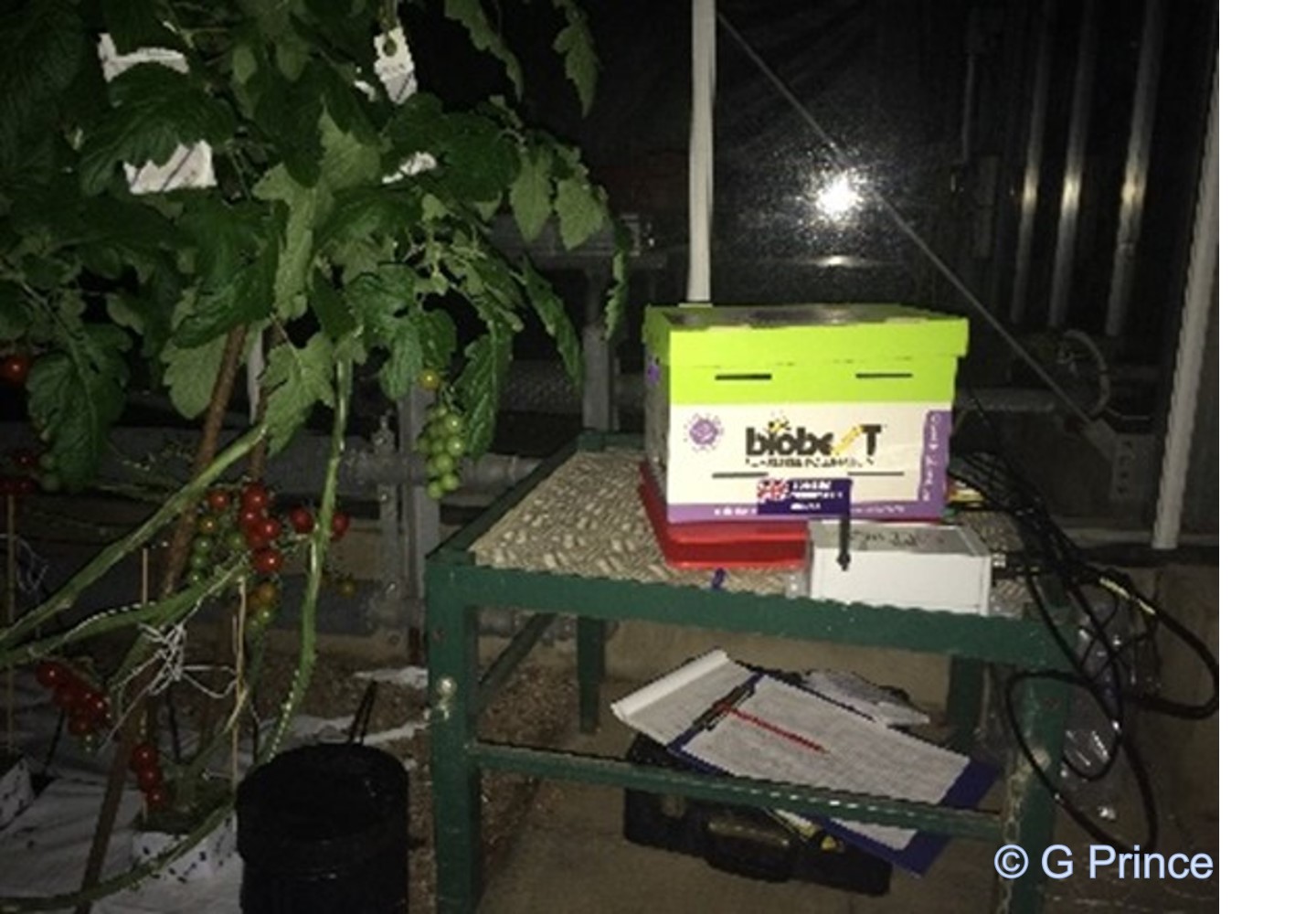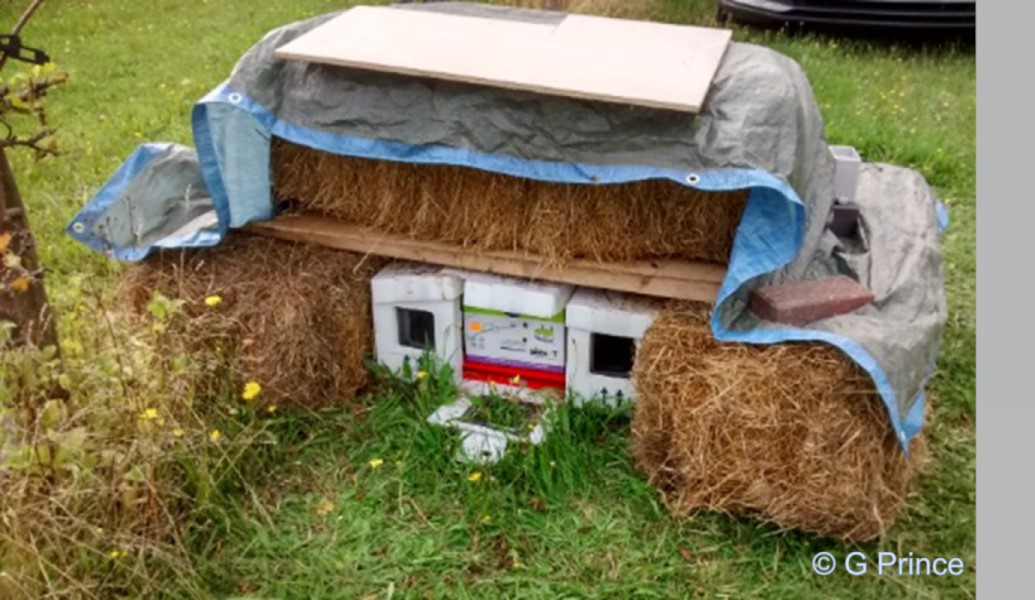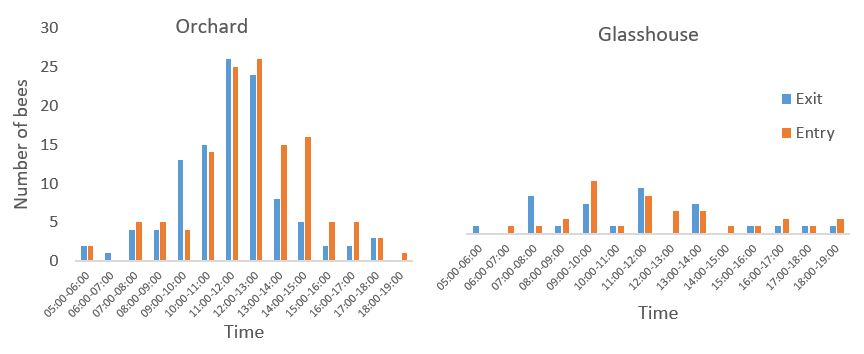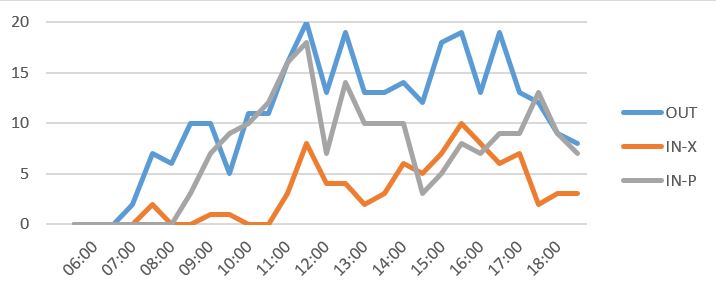Please click here to access the main AHDB website and other sectors.
- Home
- Knowledge library
- Bombus terrestris audax activity in tomato crops and natural habitats
Bombus terrestris audax activity in tomato crops and natural habitats
Read about the studies carried out to monitor the activity of Bombus terrestris audax (Bta) in glasshouse crops and natural habitats.
Comparative studies completed in 2018
This study of Bta behaviour was done at two sites at Warwick Crop Centre (WCC): a small crop of glasshouse-grown tomatoes (cv Piccolo) and an old apple orchard which was becoming naturalised. The hives in the tomato crop were set up according to normal commercial practice while the outdoor hives were set up in such a way as to simulate natural conditions with free access to a variety of flowering plants that grew in the vicinity.
‘Bee traffic’ was recorded as the rate at which bees entered and exited the hive per hour. This was done by manually counting the numbers of bees entering and exiting the hive every minute from sunrise to sunset. Data were then aggregated as numbers of bees entering / exiting per hour.
The pattern of activity was similar regardless of hive location, temperature or time of year, with the first activity seen just after sunrise, rising to a peak in activity between 11:00h and 14:00h followed by a fall in activity around 18:00h. Two short peaks of daily activity were often recorded in colonies within the tomato crops but only one, albeit more prolonged, peak was observed in hives kept outdoors.
One very notable feature was that activity in colonies kept outdoors was considerably higher (up to 25 exits per hour) than that observed when kept in the glasshouse tomato crops (up to 5 exits per hour) (Figure 1).
Figure 1. Comparison of Bta activity in a tomato crop and outside – expressed as numbers of bees entering and exiting the hives 14 August 2018
Establishing a ‘positive base-line’ for Bta performance in tomato crops
What was done:
Studies in the early part of the 2019 season were confounded by a large inherent variation in the numbers of bees present in delivered hives. As the season progressed, it became clear that it would be useful to identify a best case scenario for Bta against which we could compare other situations.
Our starting point for this scenario was a crop of baby plum tomatoes (cv Funtelle) in which there had been near complete fruit set during the preceding five months. A preliminary investigation identified two Bta colonies which stood out as performing much better than any others in that crop.
The study was done during a prolonged period of moderate weather when neither plants nor bumblebees were subjected to stressful conditions. Bee flight, flower development and pollen flow were carefully monitored from sunrise (05:22 hrs) until evening. We thus produced a ‘positive base-line’ against which we could compare flights from hives in other tomato crops, with less successful fruit set, and hives positioned in natural habitats
The findings:
The numbers of bumblebee flights in and out of two adjacent hives in the baby plum tomato crop during daylight hours on 1 August 2019 are shown in Figure 2. The return flights are divided into ‘with’ and ‘without’ full pollen sacs.
- A few bees made forays into the crop 2.5 hours after sunrise but flights out became more common during the following 30 minutes.
- Bees started returning with pollen 3 hours after sunrise.
- Exit flights peaked around 6 hours after sunrise (11:30hrs) and continued at a comparable level until 12 hours after sunrise (17:30 hrs).
- Thereafter, exit flights declined into the early evening. Bees continued to return with pollen throughout the day although there was a dip in such flights mid-afternoon.
- Our calculations indicated that 12 bees had failed to return when observations ceased at 19:00 hrs (Figure 3). They may have still been foraging or lost to the colony.
Figure 2. Bta traffic from two hives during daylight hours in a baby plum tomato crop (cv Funtelle) on 1 August 2019. Flights are recorded as ‘out’, returning with pollen (IN-P) and returning without pollen (IN-X) within 30 minute periods throughout the day.

Figure 3. Number of bees calculated to be out of the two hives within 30 minute periods throughout the day on 1 August 2019.
Bta flight activity in various situations during 2019
What was done:
Bta hives were set up in the outdoor habitat in such a way as to simulate natural conditions with free access to a variety of flowering plants that grew in the vicinity. Bee traffic was first monitored from dawn to sunset recording all exit and entry flights. The same hives were observed on a further four occasions to determine the effect of weather on flight activity.
Similar ‘snap shots’ of daily bumblebee flight activity were recorded in 31 hives over three occasions in a cherry tomato crop (cv Piccolo) in the Midlands, 8 hives in a cherry tomato crop (cv Sweet Jane) in West Sussex and 11 hives in a baby plum tomato crop (cv Funtelle) in East Yorkshire. In addition to these ‘snap shots’ of daily activity, an additional study explored flight activity over the life of colonies both in the outdoor habitat and in the tomato crop in the Midlands.
The findings:
- Bta flights between late Spring and early Autumn generally began 2-3 hours after sunrise regardless of hive location and temperature.
- The frequency of exit flights increased during the morning, peaked shortly before mid-day, remained at that level until late afternoon and then declined into the early evening.
- Exit flights within one hour of sunset were rare but return flights continued until sunset.
- Bta flight activity in the outdoor habitat was substantially greater than in the glasshouse tomato crops (Figure 4) as previously shown in Figure 1.
Figure 4. Bta flight activity (exiting and entering) per 30 minute period in hives of different ages positioned in the outdoor habitat (left) and a tomato crop (right).
Conclusions:
The combined observations of colony development (see the page on Bombus terrestris colony development in tomato crops) and flight activity provided evidence to support the opinion that Bta do not adapt well to tomato plants as a food source and / or the tomato growing environment.
When we take these results along with the data obtained from estimates of bee colony size conducted in 2018, it is clear that bee colonies placed in tomato crops do not ‘take-off’ in terms of rearing brood and producing new foragers in the same way that a colony would normally do when held outside under more natural conditions. The colonies go into decline at about two weeks from being placed in the glasshouse. Therefore it is likely that most of the pollination is being done in tomato crops by adult forager bees that are present in the hive at the time of delivery or which emerge shortly after delivery.
Useful links
Got a question? Ask a member of the team
Author
The content on this page was authored for AHDB by Mrs G Prince, Dr D Chandler and Dr Rob Jacobson (Rob Jacobson Consultancy Ltd).
 G Prince
G Prince
Locations of hive in the experimental glasshouse. © G Prince.
 G Prince
G Prince
Location of hive outside. © G Prince.




 per 30 minute period in hives of different ages positioned in the outdoor habitat (left) and a tomato crop (right)..JPG)